Homicide in Canada 2008
Archived Content
Information identified as archived is provided for reference, research or recordkeeping purposes. It is not subject to the Government of Canada Web Standards and has not been altered or updated since it was archived. Please "contact us" to request a format other than those available.
By Sara Beattie
Canada's homicide rate increased slightly in 2008
Homicide rates highest in the west and the north
Homicide rates highest in the western census metropolitan areas
Victims of homicide continue to be equally likely to be shot or stabbed
Firearm homicides up 24% since 2002
About one in four homicides were gang-related
Homicides involving other illegal activities
The large majority of victims knew their attacker
Spousal homicides continue to decline
Lowest rate of female victims ever recorded
Drop in youth accused follows peak in 2006
Summary
References
Detailed data tables
Notes
Homicides continue to be a rare occurrence in Canada, accounting for less than 1% of all violent crimes reported by police. Homicide was one of the few violent crimes to increase in 2008; by comparison attempted murders dropped 10%.1
Canadians are about six times more likely to commit suicide and about four times more likely to be killed in a traffic accident than they are to be a victim of homicide.2
Homicide is the most serious criminal offence, and a country's homicide rate is often used as a barometer of the level of violence in that society. It is also the only criminal offence that is truly comparable among nations. Compared to other countries, Canada's homicide rate continues to be about one-third that of the United States, but comparable to many European nations (Chart 1).
Chart 1
Homicide rates for selected countries

1. Figures reflect 2005 data.
2. Figures reflect 2006 data.
3. Figures reflect 2007 data.
4. Figures reflect 2008 data.
Source: Statistics Canada, Interpol Ottawa and national statistical office websites.
Canada's homicide rate increased slightly in 2008
There were 611 homicides reported by police in 2008, 17 more than the previous year, representing an increase of 2% in the homicide rate. Virtually all of the increase came from British Columbia and Alberta.
Between the mid-1960s and mid-1970s, Canada experienced a sharp rise in its homicide rate. The rate more than doubled over this period, from 1.25 homicides per 100,000 population in 1966 to 3.03 in 1975. The homicide rate generally declined over the next 25 years, dropping 42% between 1975 and 1999. Since 1999, despite some annual fluctuations, the rate has remained relatively stable (Chart 2).
Chart 2
Homicides peaked in mid-1970s
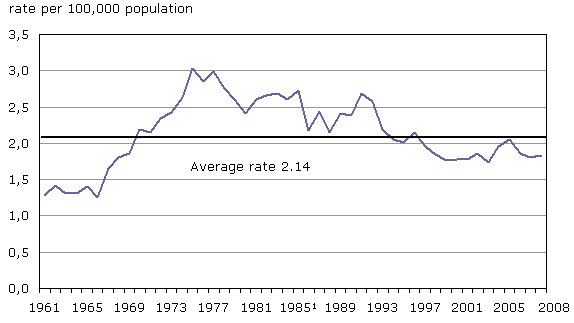
1. Excludes 329 victims killed in the Air India incident.
Source: Statistics Canada, Canadian Centre for Justice Statistics, Homicide Survey.
Homicide rates highest in the west and the north
Historically, the western provinces and the territories have reported the highest homicide rates in the country.
This trend continued in 2008 with Manitoba reporting the highest rate followed by Alberta, Saskatchewan and British Columbia. New Brunswick, Newfoundland and Labrador and Quebec reported the lowest rates (Table 1).
In 2008, two of Canada's western provinces drove the national increase in homicides: British Columbia with 117 homicides (an increase of 29 homicides from 2007) and Alberta with 110 homicides (22 more) (Table 2). The increase in both British Columbia and Alberta was mainly due to an increase in homicides committed outside of the major metropolitan areas of these provinces.
Rates in Manitoba, Saskatchewan, Ontario, New Brunswick and Nova Scotia declined from the previous year. New Brunswick's rate was the lowest in that province in 40 years as well as the lowest in the country in 2008. While Quebec's homicide rate increased slightly from the previous year, in 2008 it was still at its second lowest point in over 40 years. The decline in homicides in Ontario resulted in the second lowest homicide rate in that province since the mid 1960s; only in 2000 was the rate lower (Chart 3).
Chart 3
Highest homicide rates in Manitoba and Alberta
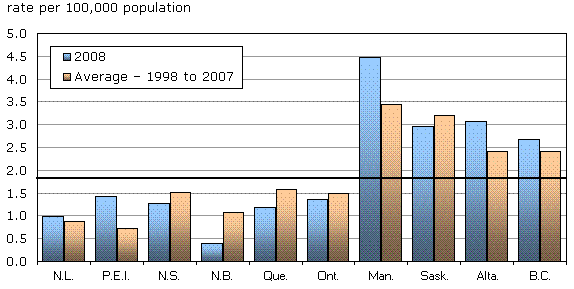
Source: Statistics Canada, Canadian Centre for Justice Statistics, Homicide Survey.
Homicide rates highest in the western census metropolitan areas
Canadians living in large urban areas tend to be at slightly less risk of being a victim of a homicide than those living in smaller urban or rural areas. In 2008, the 22.9 million Canadians living in one of the 34 census metropolitan areas (CMA) had a lower homicide rate (1.8) than the 10.4 million Canadians living outside a CMA (2.0) (Table 3).
In 2008, homicide rates in CMAs declined by 7% from the previous year, whereas rates in non-CMAs (less than 100,000 population) increased by 25% (Table 3).
In 2008, the highest homicides rates across the country were found in the metropolitan areas of western Canada. Among the 34 CMAs, the rate in Abbotsford-Mission was highest with 4.7 homicides per 100,000 population, followed by Winnipeg (4.1), Regina (3.8), Edmonton (3.4), Kelowna (3.4), Calgary (2.9) and Vancouver (2.4).
With about 1 in every 6 homicides in the country, Toronto had the highest number of homicides (103) of any CMA. However, taking population into account, Toronto's rate of 1.9 homicides per 100,000 ranked in the middle of the 10 largest CMAs and was close to the national average of 1.8 (Chart 4)
Chart 4
Among the largest census metropolitan areas homicide rates highest in west
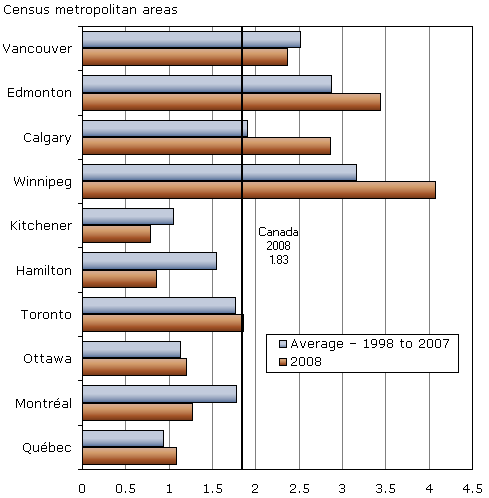
Source: Statistics Canada, Canadian Centre for Justice Statistics, Homicide Survey.
Montréal (1.3) and Hamilton (0.9) each reported their lowest homicide rates since 1981, when data first became available at the CMA level.
Victims of homicide continue to be equally likely to be shot or stabbed
For the past 30 years, there have been two primary methods used to commit homicide: shootings and stabbings. In 2008, this trend continued as shootings and stabbings each accounted for approximately one-third of all homicides. There were 200 victims killed by shooting, 12 more than the previous year, and 200 killed by stabbing, an increase of 10 from 2007.
A further 20% of victims were beaten, 7% strangled/suffocated and the remaining 7% were killed by other methods such as vehicles, fire (smoke inhalation, burns), poisoning and shaken baby syndrome (Table 4).
Firearm homicides up 24% since 2002
The overall rate of homicides committed with a firearm generally declined from the mid-1970s to 2002. However, since then, the rate of firearm homicides has generally been increasing. Between 2002 and 2008 the rate of firearm homicides went up by 24% including a 5% increase in 2008 (Chart 5).
Chart 5
Use of firearms generally increasing since 2002

1. Excludes sawed-off rifles or shotguns.
Source: Statistics Canada, Canadian Centre for Justice Statistics, Homicide Survey.
The Toronto CMA reported 50 firearm homicides and 24 gang-related homicides in 2008, the most of any CMA. Taking population into account, however, the 12 firearm homicides in Winnipeg and the 16 in Edmonton gave those metropolitan areas the highest rates among the 10 largest CMAs.
Of the 200 homicides committed with a firearm in 2008, 61% or 121 were handguns. There were also 34 homicides committed with rifles or shotguns, up slightly from 2007 (Table 5).
The use of handguns to commit homicide has generally been increasing, while the use of rifles/shotguns has generally declined over the past 30 years. Handguns were the firearm of choice in major metropolitan areas, used in 72% of all firearm homicides. In non-CMA areas, rifles or shotguns were the most prevalent, being used in almost half or 48% of all firearm homicides (Table 7).
About one in four homicides were gang-related
Gang-related homicides, which include the death of organized crime and street gang members, as well as innocent bystanders, have been increasing since the early 1990s (Chart 6). In 2008, 138 homicides were reported by police to have been gang-related, accounting for about 1 in 4 homicides. The 2008 total was 20 more than in 2007 (Table 6).
Chart 6
Gang-related homicides continue to increase
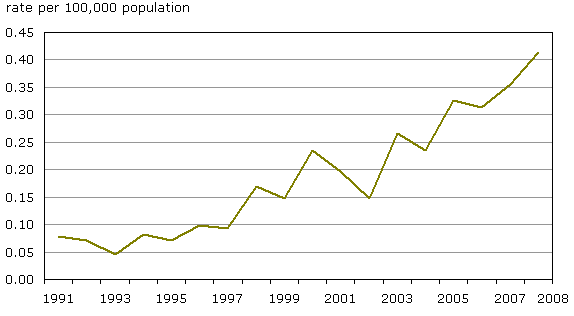
Note: These data became available beginning in 1991.
Source: Statistics Canada, Canadian Centre for Justice Statistics, Homicide Survey.
In Alberta, 35 of the 110 homicides in 2008 were gang-related, giving it the highest proportion (32%) among the provinces, followed by British Columbia (29%) and Manitoba (26%). The Atlantic Provinces (5%) and Saskatchewan (7%) reported the lowest proportions of gang-related homicides.
Two-thirds of the increase in homicides in Alberta between 2007 and 2008 was due to an increase in gang-related homicides. In British Columbia, gang-related homicides accounted for about one-third of the provincial increase in homicides.
Most gang-related homicides occurred within Canada's largest cities. The 10 largest metropolitan areas accounted for about 55% of Canada's homicides in 2008, but more than two-thirds of gang-related homicides. Calgary reported the highest rate of gang-related homicides of any of these CMAs (Table 7).
Firearms were used more often in gang-related homicides than in other types of homicide. In 2008, 77% of gang-related homicides were committed with a firearm, compared to about 20% of homicides that did not involve gangs. In 2008, the number of gang-related homicides involving handguns increased by 26% from the previous year. Most of this increase occurred in Ontario and Alberta. However, there was a slight decline in the number of handguns used in homicides overall.
Homicides involving other illegal activities
In addition to gang-related homicides,3 there were 28 homicides in 2008 that were linked to the victims' illegal activity, such as the drug trade and prostitution. This was down from 58 in 2007. Police reported three prostitutes killed as a direct result of their profession in 2008, down from an average of seven killed annually over the past decade.
In comparison, it is less common to be a victim of homicide as a direct result of legal employment. On average, 14 victims have been killed each year since 1998 while "on the-job". In 2008, there were five "legal occupation" related homicides. In 2008, there were no police officers killed as a direct result of their profession. There has been an average of three police officers murdered each year since 1961.
The large majority of victims knew their attacker
Most victims knew their killer. In 2008, 70 solved homicides (17%) were committed by someone not known to the victim, a slight increase over 2007. The rate of homicides committed by a stranger has been fairly stable over the past 30 years.
Homicide victims in Canada are most likely to be killed by an acquaintance followed by a family member. In 2008, of all solved homicides, about 40% of victims were killed by an acquaintance and 33% by a family member (Chart 7).
Chart 7
Most homicides committed by someone known to victim
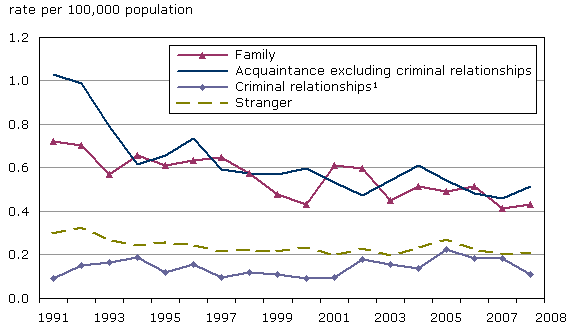
1. Includes prostitutes, drug dealers and their clients, loansharks, gang members. It should be noted that some gang homicides are scored under "acquaintance".
Source: Statistics Canada, Canadian Centre for Justice Statistics, Homicide Survey.
Spousal homicides continue to decline
The rate of spousal homicide has been generally declining since the mid-1970s. Some of the decline can be attributed to factors such as: male to female employment ratios, rising divorce rates and higher education levels for both men and women (Dawson, Pottie-Bunge and Baldé, 2009). In 2008, there were 62 spousal homicides, the same number as in 2007. The spousal homicide rate is now at its lowest point since the mid 1960s (Chart 8).
Chart 8
Spousal homicide rate generally declining over the past 30 years
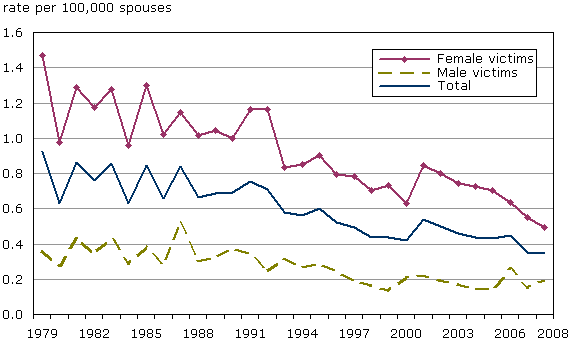
Note: Spouses include legally married, common-law, separated, and divorced persons age 15 years or older. Excludes same-sex spouses due to the unavailability of Census data on same-sex couples.
Source: Statistics Canada, Canadian Centre for Justice Statistics, Homicide Survey.
Women continue to be about three times more likely to be victims of spousal homicide than men.4 In 2008, there were 45 women and 17 men killed by a current or former spouse. Men were more likely to be killed by a common-law spouse, while women were more often killed by a legally-married spouse (Table 8).
In 2008, there was a large decline in the number of women killed by their common-law partner from 21 in 2007 to 10 in 2008.
Women also continue to be at greater risk than men of being killed by an ex-spouse. In 2008, 13 of the 45 female spousal victims were killed by a separated or divorced spouse, compared to 1 male killed by an ex-spouse.
In addition to the 62 spousal homicides, there were 27 homicides committed by a current or former boyfriend/girlfriend or intimate partner in 2008, 8 more than the previous year.
Lowest rate of female victims ever recorded
In 2008, females accounted for the lowest proportion (24%) of homicide victims recorded since data collection began. There were 146 female victims in 2008, 17 fewer than in 2007. The rate of female victims has generally been declining since the late 1960s (Chart 9). This decline may be related to the decline in spousal homicide rates over the past 30 years, which usually involve female victims, as well as the fact that gang-related homicides, which usually involve male victims, have increased.
Chart 9
Lowest rate of females killed since 1961
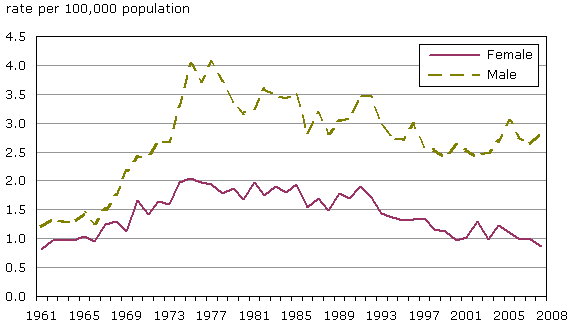
Source: Statistics Canada, Canadian Centre for Justice Statistics, Homicide Survey.
As has been the case historically, males accounted for about 9 in 10 accused persons in 2008 (Table 9). The age of males accused of homicide has been getting lower in recent years, whereas the age of female accused has been increasing. The median age of accused males has fallen from 29 in 2002 to 25 in 2008, while the age of accused females has increased from 28 in 2002 to 32 in 2008.
Drop in youth accused follows peak in 2006
Despite annual fluctuations, the rate of youth accused of homicide has remained relatively stable over the past 30 years. Overall, there were 55 youth aged 12 to 17 (51 males and 4 females) accused of homicide in 2008, 19 fewer than in 2007 (Chart 10, Table 10). The 2008 rate of female youth accused (0.3 per 100,000 youth) was the lowest recorded in the past decade.
Chart 10
Youth 12 to 17 years accused of homicide down for second consecutive year
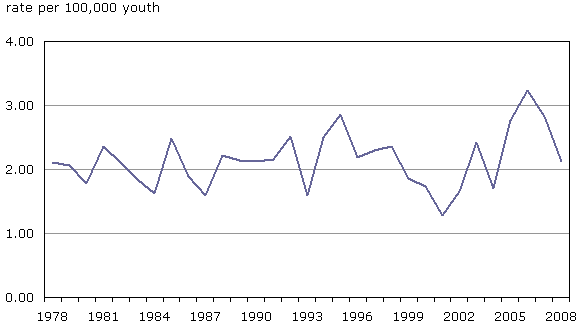
Source: Statistics Canada, Canadian Centre for Justice Statistics, Homicide Survey.
Compared to adults, higher proportions of incidents involving youth had multiple accused or were gang-related. Among incidents with an accused youth, 57% involved multiple accused compared to 17% where an adult was accused. Similarly, 32% of incidents with a youth accused involved gangs compared to 11% of incidents with an adult accused.
Homicides committed by youth in 2008 also differed from those committed by adults in the method used to kill. While the most common method employed by a youth to commit homicide in 2008 was a physical beating (38%), shootings were the most common method used by adults (37%).
Summary
In Canada, homicides are relatively rare, accounting for less than 1% of all violent crime reported to police. After peaking in 1975, the homicide rate generally declined over the next 25 years, dropping 42% between 1975 and 1999. Since 1999, the rate has been relatively stable, despite a 2% increase in 2008.
Gang-related homicides continue to increase and now account for about 1 in 4 homicides in Canada compared to 9% in 1998.
In 2008, females accounted for 24% of all homicide victims, the lowest proportion recorded since data collection began in 1961.
Canadian homicide victims are equally likely to be shot or stabbed, with each method accounting for about one-third of all homicides. The rate of firearm homicides has increased 24% since 2002 including a 5% increase in 2008. About 6 in 10 firearm related homicides were committed with a handgun in 2008.
Homicide victims in Canada are more likely to be killed by an acquaintance or a family member than a stranger. In 2008, 83% of solved homicides were committed by someone known to the victim.
After peaking in 2006 at 85, the number of youth accused of committing a homicide dropped to 74 in 2007 and to 55 in 2008.
References
Dawson, Myrna, Valerie Pottie-Bunge and Thierno Baldé. 2009. "National Trends in Intimate Partner Homicides: Explaining Declines in Canada, 1976 to 2001". Violence Against Women. Vol. 15, no. 3.
Wallace, Marnie. 2008. "Police reported crime statistics in Canada, 2008." Juristat. Vol. 29, no. 3. Statistics Canada Catalogue no. 85-002-XIE.
www.statcan.gc.ca/pub/85-002-x/2009003/article/10902-eng.htm (accessed September 28, 2009).
Detailed data tables
Table 1 Homicide rates by province or territory, 1978 to 2008
Table 2 Number of homicides by province or territory, 1978 to 2008
Table 3 Homicides by census metropolitan area
Table 4 Methods used to commit homicide, Canada, 1998 to 2008
Table 5 Homicides involving firearms, by type of firearm, Canada, 1998 to 2008
Table 6 Gang-related homicides, by region, 1998 to 2008
Table 7 Gang-related and firearm homicides, census metropolitan areas over 500,000 population, 2008
Table 8 Solved homicides by accused-victim relationship, Canada
Table 9 Homicide victims and accused persons, by sex, Canada, 1998 to 2008
Table 10 Youth (12 to 17 years) accused of homicide, Canada, 1998 to 2008
Notes
- Wallace, Marnie. 2008. "Police reported crime statistics in Canada, 2008." Juristat, Statistics Canada catalogue no. 85-002-X, vol. 29, no. 3.
- There were 2,896 deaths resulting from a traffic accident, and 3,743 suicides reported to Statistics Canada, Canadian Vital Statistics - Death Database, in 2005, the latest year for which data are available.
- There were 73 gang-related homicides which were linked to the victims' involvement in illegal activities.
- Includes common-law, separated and divorced spouses.
- Date modified:
